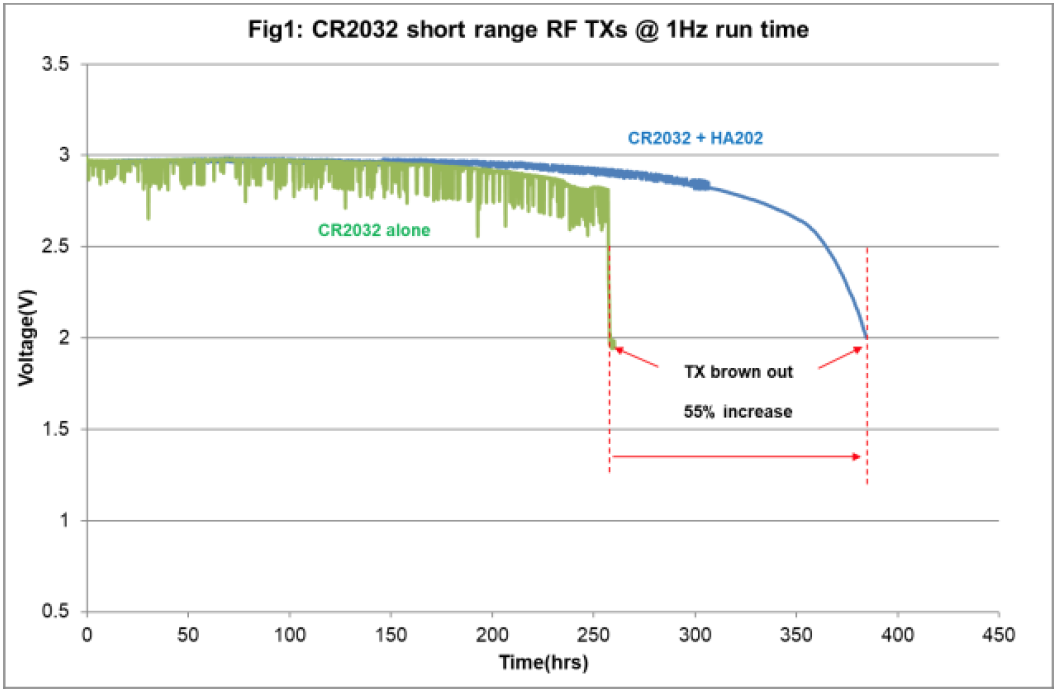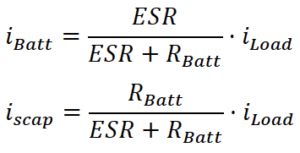SUPERCAPACITORS ENABLE WEARABLES & IOT

From smart watches to health monitoring patches, wearable devices are becoming indispensable. They need to be small, thin, long lasting and be connected. This presents a significant challenge for choosing a suitable energy source, one that a CAP-XX supercapacitor can support.
Supercapacitors deliver peak power for IoT data transmission using a coin cell …
Small coin cells such as a CR2032 are a suitable form-factor to power a wearable device. They have reasonable energy storage, ~240mAh, but poor power capability. Bluetooth Low Energy (BLE) is typically used to connect a wearable device to a cell phone app. The peak current for BLE data transmission is ~15mA. A CR2032 battery typically has an internal resistance ~10Ω when new, then this will result in a 150mV droop. As the battery is discharged, the internal resistance will increase many fold, beyond 60Ω, even with the battery still containing significant energy. This will cause the battery voltage to drop ~1V when attempting to power transmission resulting in a brown out of the BLE module. A CAP-XX supercapacitor across the battery, with an ESR of ~100mΩ reduces the voltage drop to a few mV, enabling all the energy to be extracted from the battery, increasing run time by 50%. The battery only need supply average power which is sub mW.
… and using a micro energy harvester.
An energy harvester could allow the device to run indefinitely but energy harvesters like micro generators, RF harvesters and small solar cells cannot supply the peak power required for data transmission and are an intermittent energy source. A supercapacitor can store enough energy for the wearable electronics to operate for a long period when the harvestable energy source is not available and can be charged at average current which is typically < 1mA.
APPLICATON BRIEF
AB1006 Rev 1.4
SUPERCAPACITORS ENABLE WEARABLES & IOT
From smart watches to health monitoring patches, wearable devices are becoming indispensable for many people. They need to be small, thin, long lasting and be connected to smart phones for convenience. This presents a significant challenge for choosing a suitable energy source, one that a CAP-XX supercapacitor can help alleviate.
Supercapacitor to extend battery life
Advances in modern electronics have enabled extremely low power sensors and microprocessors that draw less than 1mW power. As consumers demand more connectivity for convenience, most wearable products have integrated wireless technology. Wireless systems such as Bluetooth Low Energy, BLE, consume significantly less power than older Bluetooth protocols but a single BLE transmission still draws ~15mA for around 50ms. If a non-rechargeable wearable device uses a CR2032 battery, which typically has an internal resistance, IR= ~10Ω when new, then this will result in a 150mV droop. As the battery is discharged, the internal resistance will increase many fold even with the battery still containing significant energy. Fig 1 is an accelerated test with two CR2032 batteries, one by itself (green trace), and the other coupled with an HA202, 120mF, 120mΩ supercapacitor (blue trace), both powering a short ranged BLE TX module. The test in Fig 1 transmits once per second until the battery voltage drops to cause the module to brown-out. As the battery depletes, the internal resistance increases beyond 60Ω. Drawing 15mA sees the battery voltage drop to ~2V, causing the module to brown out even though there is still plenty of energy left in the battery. Most electronics will brown out at ~2V. Fig 1 shows that the CR2032 paralleled with a HA202 is still ~2.8V when the unsupported battery fails. This reduced voltage drops allowed the BLE Tx to utilise nearly all the energy in the battery before brown-out, hence the 55% increase in battery life can be observed in Fig1.

Supercapacitor / Battery current split
The supercapacitor and battery will share load current inversely proportional to their impedance:

Refer to Coupling a Supercapacitor with a Battery.
Supercapacitor stores energy from a harvester
Some wearable devices such as health monitoring tags are designed to be very thin and low power, an energy harvester theoretically allows the device to run indefinitely but energy harvesters like micro generators and RF harvesters cannot supply the peak power required for data transmission and are an intermittent energy source as the device may not always be moving or near a RF source.
Supercapacitors store ~1000 x more energy than a traditional capacitor with capacitance in the Farad range. A supercapacitor can store enough energy for the wearable electronics to operate for a long period when the harvestable energy source isn’t available and can be charged at average current from either an energy harvester of battery.
The energy harvester can charge the supercapacitor directly or supply a power management IC which charges the supercapacitor at very low power. The supercapacitor provides the peak power burst for data transmission as well as maintaining a steady supply voltage.
The following are some examples of supercapacitor and energy harvester:
Solar cells to power sensors (Charging a Supercapacitor from a Solar Cell Energy Harvester) reporting data wirelessly.
RF for rapid wireless charging of a supercapacitor (Wireless Charging) that enables the supercapacitor to power the wearable for example to monitor an exercise session.
Vibration transducers (micro-generator or piezo electric), eg in a shoe, to power sensors (Charging a Supercapacitor with Vibration energy harvester)
Size matters CAP-XX prismatic supercapacitor
CAP-XX produces some of the thinnest supercapacitors in the world which allows CAP-XX supercaps to be elegantly integrated in even the thinnest wearable device. See CAP-XX’s latest range of DMF low ESR high power, DMT long life high temp or DMH ultra thin supercapacitors. Some supercaps, e.g. DMH may be slightly bent to conform to the contours of the wearable device.
Sizing your supercapacitor
Supercapacitors, which can deliver high power due to their low ESR, have high C to supply sufficient energy to support the data capture and transmission for its duration, have “unlimited” cycle life, and can be charged at very low current are the perfect power buffer between the energy harvester and sensor (Powering Pulse Loads).
A range of ICs are available to charge supercapacitors from energy harvesters. To select your IC consider the characteristics of your energy harvesting transducer, the minimum voltage the IC requires to start, if the IC has peak power tracking and the method it uses, min and max power levels and efficiency at those levels.
Inrush Current Limiting
A CAP-XX very low ESR supercapacitor will try to draw very high inrush current when initially charging from 0V. In many cases the battery’s internal impedance will be a sufficient current limit, but if inrush current limiting is required, then see Current Limiting for Supercapacitors
![[GS203F] GS203F 4.5V 550mF Prismatic Super cap](/web/image/product.template/43953/image_512/%5BGS203F%5D%20GS203F%204.5V%20550mF%20Prismatic%20Super%20cap?unique=539c3a4)
![[GS206F] GS206F 4.5V 600mF Prismatic Super cap](/web/image/product.template/43954/image_512/%5BGS206F%5D%20GS206F%204.5V%20600mF%20Prismatic%20Super%20cap?unique=539c3a4)
![[GS208F] GS208F 4.5V 900mF Prismatic Super Cap](/web/image/product.template/43955/image_512/%5BGS208F%5D%20GS208F%204.5V%20900mF%20Prismatic%20Super%20Cap?unique=539c3a4)
![[GS230F] GS230F 4.5V 1200mF Prismatic Super Cap](/web/image/product.template/43956/image_512/%5BGS230F%5D%20GS230F%204.5V%201200mF%20Prismatic%20Super%20Cap?unique=539c3a4)
![[GW103F] GW103F 2.3V 1100mF Prismatic Super cap](/web/image/product.template/43948/image_512/%5BGW103F%5D%20GW103F%202.3V%201100mF%20Prismatic%20Super%20cap?unique=539c3a4)
![[GZ215F] GZ215F 5V 150mF Prismatic Super capacitor](/web/image/product.template/43943/image_512/%5BGZ215F%5D%20GZ215F%205V%20150mF%20Prismatic%20Super%20capacitor?unique=7547213)